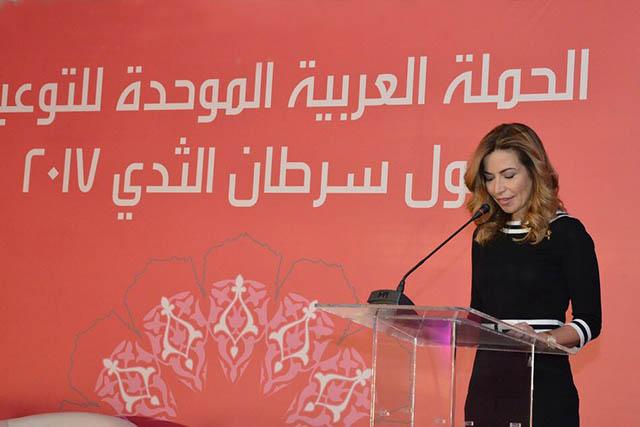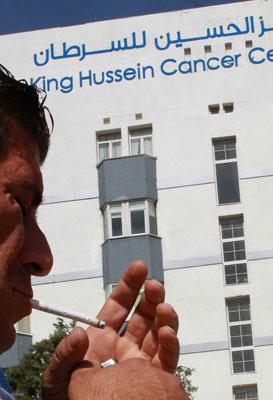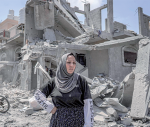You are here
Virtual session for journalists raises awareness about breast cancer, dangers of smoking
By Bahaa Al Deen Al Nawas - Oct 14,2020 - Last updated at Oct 15,2020
AMMAN — The King Hussein Cancer Foundation (KHCF) on Wednesday held a virtual session for reporters to raise awareness about issues related to breast cancer and dangers of smoking, hosing experts from the King Hussein Cancer Centre (KHCC).
Yassar Qutaiba, director of Screening and Early Detection, Community Outreach Unit at KHCC said that 5,828 new cancer cases were recorded in 2017, of which 47 per cent were among men and 53 per cent among women.
In regard to breast cancer among Jordanians, there were 1,276 cases, of which 1,266 were among women (22 per cent from all cancer types) and 10 cases were recorded among men, (0.17 per cent from all cancer types), according to Qutaiba.
“Early detection of breast cancer helps reduce the related illness and death rates and help achieve better treatment, as detection in early stages [zero, one and two] instead of advanced stages [three and four] increases cure chances and reduces treatment costs,” Qutaiba said.
She noted that for detection, women can conduct self-test, regular medical check-up and X-ray.
Self-testing can be carried out monthly for women aged 25 and above, either on the seventh or 10th day during periods, or at the first day of every month for older women at menopause, the physician said.
Women who are more vulnerable to breast cancer are those above the age of 40, those with a family history of breast cancer, such as mother or sister diagnosed with cancer, women who had their first baby after the age of 30 or never gave birth or those who carry breast cancer genes, BRCA1 and BRCA2, she noted.
Other vulnerability factors include an early or late start of a woman’s period, the use of estrogen or progestogen hormones for more than five years, exposure to radioactive therapy, overweight at the age of menopause, physical inactivity and alcohol consumption and smoking.
The signs that require quick action and a check-up include thickness in the breast, the existence of a mass in the breast or under the armpit with a different touch than the usual, among others.
“However, even with the presence of these symptoms, there is no need for fear as 80 per cent of such masses are benign, and the action needed would be to get a medical check-up, get a mammogram and have a biopsy,” she said.
The mammogram is for women above 40 years of age, even if they do not have any symptoms. X-ray is also a good tool for early detection, which can detect small tumours that cannot be seen or felt through self-testing, she said.
Treatment methods include an MRI scan of the breasts, surgery, chemotherapy, hormone treatment and radioactive therapy, Qutaiba said.
In the second part of the virtual session, Pharmacist, Communication and Outreach Specialist at the Cancer Control Office at the KHCC Rasha Manasra said that according to the World Health Organisation, there are 1.3 billion smokers around the world, 84 per cent of whom come from developing countries.
“One out of five teenagers aged between 13 and 15 are smokers, while around 80,000 to 10,000 teenagers start smoking on a daily basis, and 40 per cent of teenagers in the world are vulnerable to smoking at home,” Manasra said.
Jordan ranks first in regard to the use of tobacco among men in the Middle East and second in the world, as 70 per cent of Jordanian men are smokers, while 10 per cent of women are smokers as well, Manasra said, noting that the percentage can be higher as many women, due to cultural reasons, refuse to admit that they smoke or consider that hookah or vape are not forms of smoking, but rather only tobacco.
Moreover, 32 per cent of teenagers in Jordan smoke, there are more than a million adult smokers in the Kingdom, more than 9,000 children aged between 10 and 14 are smokers and 82 per cent of regular smokers have smoked their first cigarette before the age of 18.
Eight out of 10 men in Jordan smoke or use nicotine products regularly, including e-cigarettes, Manasra said, citing information from an article by British newspaper The Guardian, which quotes studies conducted by the Ministry of Health and other health entities in cooperation with WHO, after which Jordan ranked first in the world in regard to smoking.
“An average of 21.3 cigarettes is consumed daily by smokers in the Kingdom, and if you ask one if they smoke a lot, they shrug it off saying it’s only one packet, although it is a very large amount,” Manasra said.
Manasra said that everybody is aware of the negative impact of smoking on people’s health, causing early deaths, chronic diseases, high healthcare costs, environmental degradation and economic losses.
“Last year, when there were comments that tobacco use should be controlled further, an official said that tobacco supports the Jordanian economy, so at the KHCC we did a fact check to provide proper numbers based on existing studies,” she said.
“We found a study by WHO from 2015 on how much revenue is made from tobacco and how much it costs. We found that tobacco contributes around JD889 million to the economy, but on the other hand it causes JD1.6 billion in losses, of which JD990 million are the cost of smoking at the workplace, constituting 62 per cent,” Manasra added.
A total of JD204 million of the losses are the cost of healthcare related to tobacco, 15 per cent, and JD339 million are the costs related to tobacco deaths, 25 per cent, she said.
The average total loss against the revenues stands at around JD726 million, she noted.
Manasra highlighted the need for better implementation of law, especially in regard to banning smoking in public places.
Comparing smoking-related deaths with coronavirus fatalities, Manasra said that 9,000 deaths are caused by smoking annually, while 191 COVID-19 deaths had been recorded in the Kingdom until October 12.
She stressed that awareness is key with focus in the media on deaths caused by smoking.
Related Articles
Cancer screening for women, as it is for men, is extremely important.
AMMAN — Jordan is joining several Arab countries in an awareness campaign encouraging women to undergo screenings for early detection and di
AMMAN — Yazeed was 12 years old when he had his first shisha, an instrument for vaporising and smoking flavoured tobacco.

















